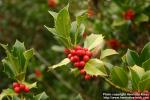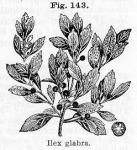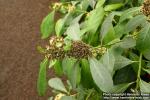 Related entry: Prinos.—Black Alder
Related entry: Prinos.—Black Alder
The leaves of Ilex opaca, Aiton.
Nat. Ord.—Aquifoliaceae.
COMMON NAME: American holly.
Botanical Source.—This tree rises from 20 to 40 feet in height, having leaves which are alternate, coriaceous, evergreen, smooth, and shining, flat, oval, acute at the end, and the wavy margins armed with strong, scattered, spiny teeth. The flowers are small, greenish-white, arranged in scattered clusters along the base of the young branches, and borne from the axils of the leaves. The calyx is persistent; the calyx-teeth acute. The corolla is rotate, monopetalous, and 4-cleft; the stamens erect and alternate with the divisions. The ovary is globular, and 4-celled. Stigmas 4, subsessile, and obtuse. The fruit is a red, globular berry of 4 cells; the nutlets are 4 and striate (G.—W.).
History and Chemical Composition.—The holly is found growing throughout the United States from Maine to Louisiana, in moist woodlands, and flowering in June. It is quite common to the Atlantic states, especially New Jersey. The viscid substance of the inner bark, like the mistletoe berry, furnishes an adhesive material known as birdlime. The berries are about as large as a whortleberry, of a red color, and an acrid, bitterish taste. The leaves are the medicinal parts. They have a bitter, somewhat harsh taste, but no odor, and yield their virtues to water or alcohol. They are believed to contain ilicin (see Related Species), wax, gum, salts, etc. (For the preparation of Rousseau's ilicin, see this Dispensatory, last revision.) Mr. D. P. Pancoast (Amer. Jour. Pharm., 1856, Vol. XXVIII, p. 315) prepared from the leaves of American holly an aqueous decoction from which the bitterness was removed by charcoal, and subsequently abstracted from the latter by alcohol. An amorphous, non-hygroscopic, intensely bitter mass resulted upon evaporation of the solvent, partially soluble in water, and completely soluble in alcohol and ether. It could not be obtained in the crystallized state. By the same process the author isolated from the berries a crystallizable, very bitter principle, soluble in ether, water, and alcohol. Acids precipitate it from aqueous solution. The fruit contains tannin. Mr. Walter A. Smith (Amer. Jour. Pharm., 1887, p. 230) obtained from the leaves, by extraction with benzin, a volatile oil of an acrid, mustard-like odor, and also identified a glucosid. The leaves contained 4.5 per cent of ash.
Action, Medical Uses, and Dosage.—Holly leaves are tonic and febrifuge; said to be very efficient in the treatment of intermittent fevers, in doses of 60 grains of their powder administered 1 or 2 hours previous to the chill. The infusion has also proved beneficial in icterus, pleuritis, catarrh, variola, arthritis, etc. The berries are said to be emeto-cathartic and cholagogue; from 8 to 15 of them will act as a hydragogue. According to Dr. Rousseau, ilicin acts decidedly upon the spleen, liver, and pancreas, producing a sedative effect, and is a cheap substitute for quinine. Its dose is 10 grains in pill form, gradually increased to 30 grains.
 Related Species.—Ilex aquifolium, Linné, European holly, together with several other species in this country, possess properties similar to those of American holly. Dr. F. Moldenhauer has found in the leaves a crystalline yellow coloring matter, which is scarce in the leaves when they are collected in January, but abundant when gathered in August. It is soluble in alcohol or hot water, but insoluble in ether of cold water, loses its color at 185° C. (365° F.), and fuses at 197.7° C. (388° F.), decomposing slightly above this temperature. He gave it the name ilixanthin (C17H22O11). He also isolated from the aqueous extract the crystallizable calcium salt of a syrupy acid, ilicic acid. Ilicin is the bitter principle upon which the febrifuge properties of the leaves depend; it has not been obtained as yet in a pure state. The leaves have been used in intermittent fevers and rheumatism, and the berries in dropsy. The leaves produce gastric heat, nausea, and colic. The berries have emeto-cathartic properties.
Related Species.—Ilex aquifolium, Linné, European holly, together with several other species in this country, possess properties similar to those of American holly. Dr. F. Moldenhauer has found in the leaves a crystalline yellow coloring matter, which is scarce in the leaves when they are collected in January, but abundant when gathered in August. It is soluble in alcohol or hot water, but insoluble in ether of cold water, loses its color at 185° C. (365° F.), and fuses at 197.7° C. (388° F.), decomposing slightly above this temperature. He gave it the name ilixanthin (C17H22O11). He also isolated from the aqueous extract the crystallizable calcium salt of a syrupy acid, ilicic acid. Ilicin is the bitter principle upon which the febrifuge properties of the leaves depend; it has not been obtained as yet in a pure state. The leaves have been used in intermittent fevers and rheumatism, and the berries in dropsy. The leaves produce gastric heat, nausea, and colic. The berries have emeto-cathartic properties.
Ilex Cassine, Walter (Ilex vomitoria, of Aiton), or South Sea tea, an evergreen shrub, growing in the southern states, is the Cassine of the Indians. It is also known as Cassena, Yaupon or Youpon. A liquid, called black drink, is prepared by boiling the toasted leaves in water; in the performance of their religious rites, and on great occasions when in council, the men only are permitted to drink this, for the purpose of cleansing their systems. The leaves have a rough, aromatic taste, no odor, and in large doses their decoction causes active emesis, catharsis, and diuresis; in small quantity it greatly increases the urinary discharge. A few leaves of this plant lessen the injurious influence of saline water, and it is used for this purpose by persons along the sea shore in North Carolina. According to the analysis of Dr. F. P. Venable (Amer. Jour. Pharm., 1885, p. 390), the dried leaves contain 0.32 per cent of caffeine, 7.39 per cent of tannin, and 5.75 per cent of ash. Mr. Henry M. Smith (Amer. Jour. Pharm., 1872, p. 216) found 0.011 per cent of a volatile oil, 3.4 per cent of resin, and 0.122 per cent of caffeine. (For a detailed and exhaustive article on Ilex Cassine see monograph by Edwin M. Hale, M. D., Bulletin No. 14, Division of Botany, U. S. Department of Agriculture.)
 Ilex glabra. Ink berry.—Sandy grounds from New England to Florida. Employed chiefly for ornamentation, and was at one time used in intermittent fevers.
Ilex glabra. Ink berry.—Sandy grounds from New England to Florida. Employed chiefly for ornamentation, and was at one time used in intermittent fevers.
Ilex Dahoon, Walter; Dahoon holly, and Ilex myrtifolia, Walter; both of southern states, are also known as Cassena.
 Related entries: Caffea.—Coffee - Thea.—Tea - Theobroma.—Cacao - Guarana (U. S. P.)—Guarana - Kola.—Kola
Related entries: Caffea.—Coffee - Thea.—Tea - Theobroma.—Cacao - Guarana (U. S. P.)—Guarana - Kola.—Kola
Ilex paraguayensis, St. Hilaire; Argentine Republic, and Brazil.—This tree yields Paraguay tea or Yerba maté, St. Bartholomew's tea or Jesuit's tea, which is consumed in immense quantities in South America in place of Chinese tea. Its effects are said to more nearly resemble coca than tea. The plant grows along water courses, and from December to August collecting parties gather the leaves which, after a preparatory torrification to enhance their aroma, are powdered and enter into commerce and are sold to be prepared by infusion like common tea. Their chief constituent is caffeine, which exists in quantities varying from 0.2 per cent to 1.8 per cent, the average yield (Peciolt) being 0.64 per cent. Tannin (matetannic acid) is present in amounts of from 10 to 16 per cent (A. Robbins, Amer. Jour. Pharm., 1878, p. 273). The leaves are most aromatic just before the fruit is ripe. Volatile oil, a stearopten, and a crystallizable acid, mateviridic acid, have also been obtained from the leaves. The infusion of Paraguay tea is diuretic and sudorific, and in excessive doses acts as a drastic purgative. (For an interesting article on maté or Paraguay tea, see Th. Peckolt, Amer. Jour. Pharm., 1883, p. 570.)

